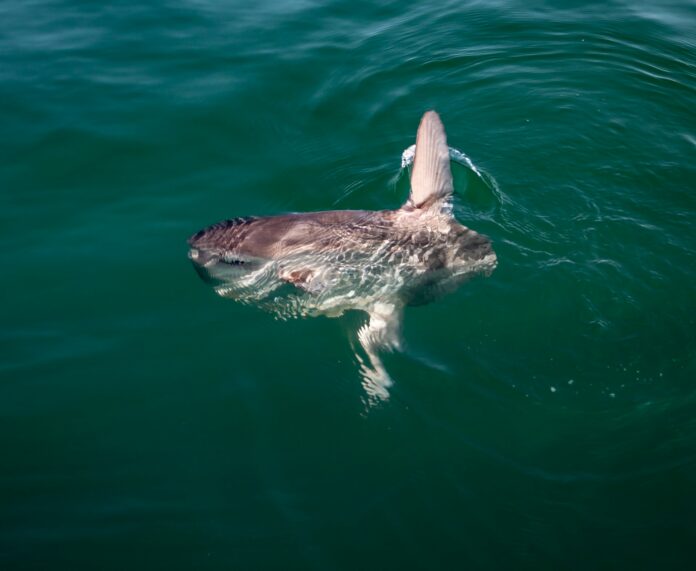Unusual sighting of massive hoodwinker sunfish draws crowds in Oregon
A remarkable discovery unfolded on Oregon’s northern coast as a colossal and rare hoodwinker sunfish, typically found in temperate waters of the southern hemisphere, washed ashore, captivating the attention of locals and garnering worldwide fascination.
The 7.3-foot (2.2 meter) sunfish made its unexpected appearance on Gearhart Beach on Monday, as confirmed by the Seaside Aquarium. Remarkably, it remained stranded on the beach till Friday and is expected to linger for weeks due to its resilient skin, making it challenging for scavengers to penetrate.
Photographs shared by the aquarium depicted the massive, flat, grey fish lying on the sandy shore, offering a glimpse of its sheer size and scale. Individuals kneeling beside it and a parked pickup truck nearby provided perspective on its immense dimensions.
The buzz generated on social media prompted Marianne Nyegaard, a researcher from New Zealand specializing in sunfish, to reach out to the aquarium. Upon examining photographs of the fish, Nyegaard confirmed its identity as a hoodwinker sunfish — a species even rarer than the commonly seen ocean sunfish. She speculated that it might be the largest specimen ever recorded.
In a groundbreaking study published in 2017, Nyegaard unveiled the hoodwinker sunfish, scientifically known as Mola tecta, as a distinct species separate from the ocean sunfish, Mola mola. The Latin term “tecta,” meaning hidden or disguised, aptly reflects the new species that had eluded discovery despite its conspicuous presence.
Despite its presumed habitat in the southern hemisphere, the hoodwinker sunfish has surprised researchers by washing ashore on the California coast in previous instances. Recent sightings in California and Alaska challenge previous assumptions about its range. Additionally, the aquarium suggests that the fish might have been misidentified as the ocean sunfish in past sightings along the Pacific Northwest coastline.
Analysis:
Environmental Impact
The appearance of the hoodwinker sunfish in unexpected locations raises questions about shifts in oceanic currents, temperature patterns, and ecological changes affecting marine species distribution. Researchers and environmentalists may investigate these phenomena to understand their implications for marine biodiversity and conservation efforts.
Scientific Discovery
Nyegaard’s groundbreaking research underscores the ongoing exploration and discovery of new species, even in well-studied ecosystems. The identification of the hoodwinker sunfish highlights the importance of genetic analysis and interdisciplinary collaboration in advancing scientific knowledge and taxonomy.
Ecotourism Potential
The rare sighting of the hoodwinker sunfish presents a unique opportunity for ecotourism and educational initiatives along Oregon’s coastline. Local communities and conservation groups may leverage the event to promote marine conservation awareness and sustainable tourism practices.
Cultural Significance
The widespread interest generated by the sunfish’s discovery reflects the enduring fascination with marine life and the natural world. It serves as a reminder of humanity’s deep connection to the oceans and the importance of preserving these habitats for future generations.
Wildlife Management
The unexpected appearance of the hoodwinker sunfish underscores the need for effective wildlife monitoring and management strategies along coastal regions. Authorities may implement measures to safeguard vulnerable species and mitigate human impacts on marine ecosystems.
